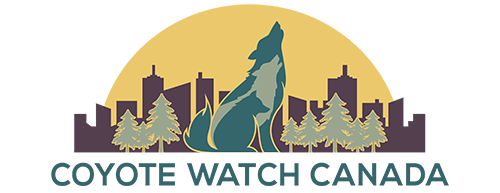For the last seventeen months throughout Niagara, Coyote Watch Canada (CWC) and several very enthusiastic volunteers and residents have been diligently hazing coyotes to discourage them away from feeding “hot spots”. To date, there are many happy and relieved faces that reflect the positive results of hazing our local Song Dogs. Old attitudes and the restricting beliefs people carried about coyotes have also disappeared.
Compassionate wildlife communities such as Niagara Falls; Denver, Colorado and Calabasas, CA are consciously moving away from the old “kill” approach that essentially does not acknowledge or identify any precursors behind coyote behaviour, such as food drivers. Unfortunately, the media’s consistent use of sensational and negative wording to describe coyote behaviour such as “lurking”, “marauding” and “stalking” adds fuel to the ineffective and short sighted approach of permanent coyote removal. Sensationalism sells papers, not the critical insight needed to understand our relationship with coyotes and the damaging impact feeding has on the very nature of these creatures.
Coyote proximity and tolerance to people increases when the reward is food. Plain and simply put, we train coyotes to develop some pretty bad habits. Can we really blame this amazing wild dog for being so adaptable in its response to our carelessness when we continuously feed them? Take the food away permanently and simultaneously introduce hazing, and the results are short of a miracle. Our coyotes now react to a firm strong voice and flee immediately.
Initially, hazing a very habituated family of coyotes was a frustrating, exhilarating and exhausting (for me) process. At “Location Eleven”, the alpha pair and their yearling had no previous experience to draw from when responding to the persistent human that became the alpha in their world. Since coyotes have the brilliant and innate ability to adapt quickly to their ever changing environment, this family developed their own “response repertoire”, which today includes staying far away from feeding sites, me and other people.
The coyotes at Location Eleven also recognize and avoid vehicles that once, historically represented an easy meal. Just as a drive through restaurant is to us, coyotes respond well to a ready made meal. Even if that food comes with the risk of associating too close with humans. The success of hazing is linked to consistent follow through during application, the permanent removal of food incentives, flexibility and modification of stimulus and sincere patience on everyone’s part. Coyotes and the people that feed them, require an adjustment period.
Hazing is effective much to the naysayers, and negative Nelli’s that claim it falls short. Truth be known, CWC had to revisit three of the former locations where there was chronic human feeding. Repeat “feeders” were bringing in the wildlife! It is frustrating and requires active meditation when you see the same situation over and over. Again, patience is required, particularly with people. Coexistence programs must be a lifelong commitment by us all, rooted in prevention and safety initiatives. When feeding resurfaces at a post hazed location, coyotes put us on notice by their presence. Transient coyotes may also show up when a “drop by” meal is being served.
The City of Niagara Falls has a coyote feeding by-law that provides city staff with a vital education and enforcement tool. The $5000.00 fine is hefty and a necessary deterrent. Public announcements and door to door notices about the dangers of feeding coyotes is part of the public education out reach that CWC volunteers deliver. Partnerships with stakeholders and residents empowers and engages everyone in the community to strive for coexistence. A glorious opportunity is created by programs that teach tolerance, responsibility and preservation for coyotes and other wildlife that share this planet.
The evolution of a compassionate heart is connected to coyote and how we deal with this fairly new arrival to our communities. Ethically, we cannot keep killing these sentient animals. When interviewed by reporter Michael Howie, coyote expert Dr. Marc Bekoff, highlighted the obvious reasons why NOT to kill coyotes. “Even if you don’t care about the ethics, look at the data. This kind of control simply does not work.” Citing a town near his home outside of Boulder, Colorado, Bekoff noted the ineffectiveness in culls as an urban solution.”Every year, they have this problem of coyotes. They’ve killed dozens of them. I finally said, ‘every year you have this problem and since you’ve killed the coyotes, the only common factor is people. What’s perpetuating this behaviour?’”
Non-lethal methods such as hazing are a sensible and hopeful place to start with coyotes. It is a joyful moment to see one of your very own (hazed coyotes) doing what they do best, hunting natural prey. The Location Eleven coyote family will continue to challenge us all I suspect, to act more responsibly and be accountable for our behaviour. Is it possible to change coyotes? Here in Niagara, we know it is. We also take into account it has very little to do with coyotes and a great deal to do with us when conflict comes knocking. Bringing out nature’s best and beautiful in our coyotes requires outgrowing some really bad habits within ourselves.

